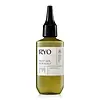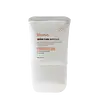What's inside
What's inside
 Key Ingredients
Key Ingredients

 Benefits
Benefits

 Concerns
Concerns

 Ingredients Side-by-side
Ingredients Side-by-side

Water
Skin ConditioningAlcohol Denat.
AntimicrobialSilica
AbrasiveCamellia Sinensis Leaf Extract
AntimicrobialChamomilla Recutita Flower Water
MaskingCarbomer
Emulsion StabilisingTromethamine
BufferingGlycerin
HumectantParfum
MaskingMenthol
MaskingDisodium EDTA
Limonene
PerfumingButylene Glycol
HumectantPiroctone Olamine
PreservativePropanediol
SolventPanax Ginseng Root Cell Extract
Skin Conditioning1,2-Hexanediol
Skin ConditioningCamellia Japonica Seed Oil
EmollientCamellia Sinensis Seed Oil
HumectantGlycine Max Polypeptide
Skin ConditioningLavandula Angustifolia Oil
MaskingRosmarinus Officinalis Leaf Oil
MaskingCitrus Aurantium Bergamia Fruit Oil
MaskingZingiber Officinale Root Extract
MaskingCamellia Japonica Flower Extract
EmollientPanax Ginseng Extract
AntioxidantRosa Damascena Flower Extract
MaskingCentella Asiatica Flower/Leaf/Stem Extract
Skin ConditioningEthylhexylglycerin
Skin ConditioningGlycine Max Oil
EmollientGlycine Max Seed Extract
Skin ConditioningCeramide NP
Skin ConditioningPhytosphingosine
Skin ConditioningHydrogenated Lecithin
EmulsifyingCanola Oil
EmollientRosmarinus Officinalis Leaf Extract
AntimicrobialWater, Alcohol Denat., Silica, Camellia Sinensis Leaf Extract, Chamomilla Recutita Flower Water, Carbomer, Tromethamine, Glycerin, Parfum, Menthol, Disodium EDTA, Limonene, Butylene Glycol, Piroctone Olamine, Propanediol, Panax Ginseng Root Cell Extract, 1,2-Hexanediol, Camellia Japonica Seed Oil, Camellia Sinensis Seed Oil, Glycine Max Polypeptide, Lavandula Angustifolia Oil, Rosmarinus Officinalis Leaf Oil, Citrus Aurantium Bergamia Fruit Oil, Zingiber Officinale Root Extract, Camellia Japonica Flower Extract, Panax Ginseng Extract, Rosa Damascena Flower Extract, Centella Asiatica Flower/Leaf/Stem Extract, Ethylhexylglycerin, Glycine Max Oil, Glycine Max Seed Extract, Ceramide NP, Phytosphingosine, Hydrogenated Lecithin, Canola Oil, Rosmarinus Officinalis Leaf Extract
Water
Skin ConditioningAlcohol Denat.
AntimicrobialButylene Glycol
HumectantCaffeine
Skin Conditioning1,2-Hexanediol
Skin ConditioningHydroxyacetophenone
AntioxidantTromethamine
BufferingCarbomer
Emulsion StabilisingPEG-60 Hydrogenated Castor Oil
EmulsifyingMenthol
MaskingTrideceth-10
CleansingDisodium EDTA
Betaine
HumectantGlycerin
HumectantEucalyptus Globulus Leaf Oil
PerfumingVincetoxicum Atratum Extract
Skin ConditioningHouttuynia Cordata Extract
Skin ConditioningCamellia Japonica Flower Extract
EmollientPrunus Mume Flower Extract
Skin ConditioningPrunus Persica Flower Extract
MoisturisingAlthaea Rosea Flower Extract
Skin ConditioningViola Mandshurica Flower Extract
AntioxidantHelianthus Annuus Flower Extract
Skin ConditioningInula Britannica Flower Extract
Skin ConditioningLysimachia Foenum-Graecum Extract
Skin ConditioningWater, Alcohol Denat., Butylene Glycol, Caffeine, 1,2-Hexanediol, Hydroxyacetophenone, Tromethamine, Carbomer, PEG-60 Hydrogenated Castor Oil, Menthol, Trideceth-10, Disodium EDTA, Betaine, Glycerin, Eucalyptus Globulus Leaf Oil, Vincetoxicum Atratum Extract, Houttuynia Cordata Extract, Camellia Japonica Flower Extract, Prunus Mume Flower Extract, Prunus Persica Flower Extract, Althaea Rosea Flower Extract, Viola Mandshurica Flower Extract, Helianthus Annuus Flower Extract, Inula Britannica Flower Extract, Lysimachia Foenum-Graecum Extract
Ingredients Explained
These ingredients are found in both products.
Ingredients higher up in an ingredient list are typically present in a larger amount.
1,2-Hexanediol is a synthetic liquid and another multi-functional powerhouse.
It is a:
- Humectant, drawing moisture into the skin
- Emollient, helping to soften skin
- Solvent, dispersing and stabilizing formulas
- Preservative booster, enhancing the antimicrobial activity of other preservatives
Alcohol Denat. is an alcohol with a denaturant property. It is created by mixing ethanol with other additives.
This ingredient gets a bad rep because it is irritating and drying - mostly due to its astringent property. Astringents draw out natural oils in tissue, constricting pores and leaving your skin dried out.
However, alcohol denat. is not all that bad.
Due to its low molecular weight, alcohol denat. tends to evaporate quickly. One study on pig skin found half of applied alcohol evaporated in 10 seconds and less than 3% stayed on skin.
This also helps other ingredients become better absorbed upon application.
Studies are conflicted about whether this ingredient causes skin dehydration. One study from 2005 found adding emollients to propanol-based sanitizer decreased skin dryness and irritation. Another study found irritation only occurs if your skin is already damaged.
Small amounts of alcohol are generally tolerated by oily skin or people who live in humid environments.
The rule of thumb is if this alcohol is near the end of an ingredients list, it will probably not affect your skin much.
Also...
This ingredient has antimicrobial and solvent properties.
The antimicrobial property helps preserve products and increase their shelf life. As a solvent, it helps dissolve other ingredients.
Other types of astringent alcohols include:
Learn more about Alcohol Denat.Butylene Glycol (or BG) is used within cosmetic products for a few different reasons:
Overall, Butylene Glycol is a safe and well-rounded ingredient that works well with other ingredients.
Though this ingredient works well with most skin types, some people with sensitive skin may experience a reaction such as allergic rashes, closed comedones, or itchiness.
Learn more about Butylene GlycolCamellia Japonica Flower Extract comes from the Japanese Camellia plant. This plant is native to East Asia and known as "Tsubaki" in Japanese.
Tsubaki flowers possess antioxidant and soothing properties. This flower has shown to be effective at fighting pollution damage by protecting your skin's fibroblasts. Your skin's fibroblasts help create collagen and collagen is responsible for youthful, plump skin.
This flower also contains many antioxidant enzymes. Antioxidants help fight free-radical molecules. Free-radical molecules are capable of damaging our cells and other genetic material. They may originate from sunlight, air pollution, or cigarette smoke. These free-radical molecules are unstable and are often looking for missing electrons. This instability causes free-radicals to damage our cells. Antioxidants help stabilize free-radicals by donating extra electrons.
Thus, Camellia Japonica Flower Extract may help reduce the signs of aging.
Learn more about Camellia Japonica Flower ExtractCarbomer is a polymer of acrylic acid. Its main role is to create a gel consistency.
A high amount of carbomer can cause pilling or balling up of products. Don't worry, most products contain 1% or less of carbomer.
Disodium EDTA plays a role in making products more stable by aiding other preservatives.
It is a chelating agent, meaning it neutralizes metal ions that may be found in a product.
Disodium EDTA is a salt of edetic acid and is found to be safe in cosmetic ingredients.
Learn more about Disodium EDTAGlycerin is already naturally found in your skin. It helps moisturize and protect your skin.
A study from 2016 found glycerin to be more effective as a humectant than AHAs and hyaluronic acid.
As a humectant, it helps the skin stay hydrated by pulling moisture to your skin. The low molecular weight of glycerin allows it to pull moisture into the deeper layers of your skin.
Hydrated skin improves your skin barrier; Your skin barrier helps protect against irritants and bacteria.
Glycerin has also been found to have antimicrobial and antiviral properties. Due to these properties, glycerin is often used in wound and burn treatments.
In cosmetics, glycerin is usually derived from plants such as soybean or palm. However, it can also be sourced from animals, such as tallow or animal fat.
This ingredient is organic, colorless, odorless, and non-toxic.
Glycerin is the name for this ingredient in American English. British English uses Glycerol/Glycerine.
Learn more about GlycerinMenthol is a compound found in mint plants, such as peppermint. In its pure form, it is a clear crystalline substance.
Menthol is known for its cooling sensation; however, the cooling is actually from your skin being sensitized. Menthol can worsen rosacea. We recommend speaking with a professional if you have concerns.
Menthol also has antimicrobial properties.
Learn more about MentholTromethamine helps balance the pH and improve the texture of a product. It is synthetically created.
As an emulsifier, Tromethamine prevents oil and water ingredients from separating. This helps stabilize the product and elongate a product's shelf life. Tromethamine also makes a product thicker.
Tromethamine helps balance the pH level of a product. Normal pH level of skin is slightly acidic (~4.75-5.5). The acidity of our skin is maintained by our glands and skin biome. Being slightly acidic allows our skin to create an "acid mantle". This acid mantle is a thin barrier that protects our skin from bacteria and contaminants.
Oral Tromethanmine is an anti-inflammatory drug but plays the role of masking, adding fragrance, and/or balancing pH in skincare.
1,3-Propanediol, 2-amino-2-(hydroxymethyl)-
Learn more about TromethamineWater. It's the most common cosmetic ingredient of all. You'll usually see it at the top of ingredient lists, meaning that it makes up the largest part of the product.
So why is it so popular? Water most often acts as a solvent - this means that it helps dissolve other ingredients into the formulation.
You'll also recognize water as that liquid we all need to stay alive. If you see this, drink a glass of water. Stay hydrated!
Learn more about Water